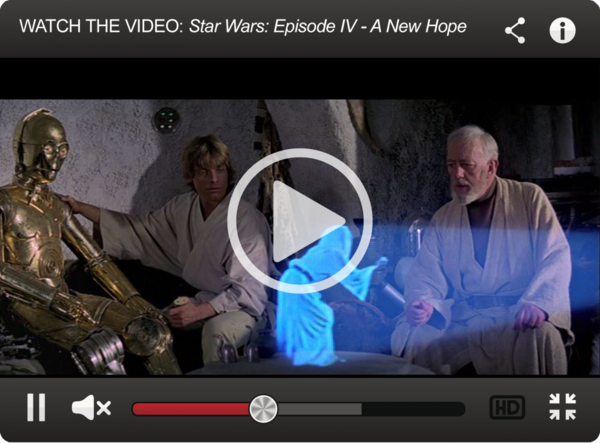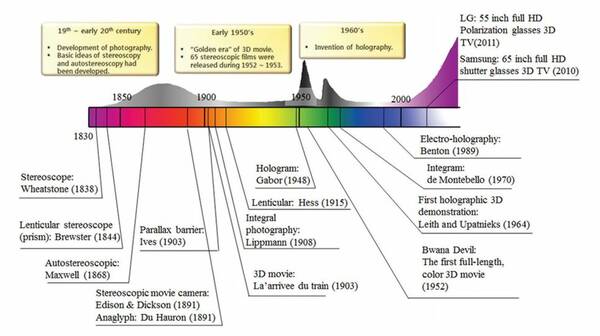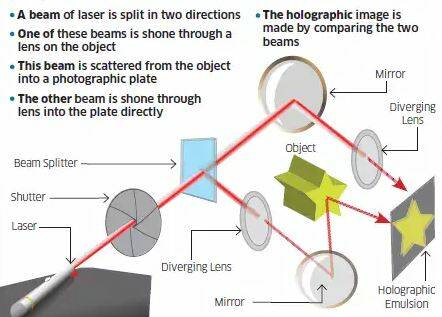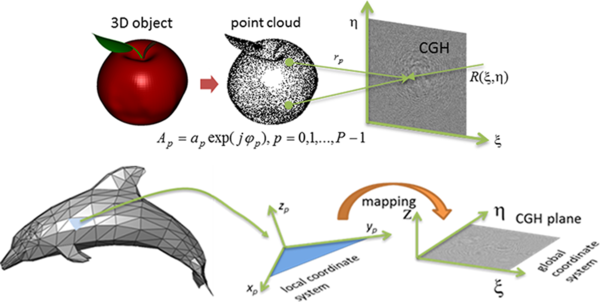Seeing in 3D: Advancements in Holographic Display Technology
“Help me, Obi-Wan Kenobi. You’re my only hope.” In 1977, these words first introduced Star Wars audiences to Princess Leia, perhaps the most famous hologram in history. Except, she wasn’t really a three-dimensional (3D) hologram—the projection was a product of movie special-effects magic, just an image on film, because 3D holographic technology didn’t exist at the time. Since then, however, the idea of 3D “Star Wars-style” holograms has set the bar for technology developers to produce displays that at one time seemed “far, far away.”

(Copyright ™ and ® Lucasfilm, Ltd. All Right Reserved)
And recently, it seems like we might be almost there. Advancements in holographic technology coupled with the advent of high-speed/high-latency 5G networks means within a few years you could have a holographic phone that mimics science fiction—in your own living room. For example:
- Vodaphone used a 5G network to conduct a live holographic call in Britain. They transmitted a 3D image of a person standing in Manchester to a VR headset outside of London, and simultaneously projected the person’s image onto a stage in front of a live audience.
- Verizon and Korean Telecom also used a 5G network to enable an employee in Seoul to have a live conversation with the 3D hologram of an employee in New Jersey.
Holographic History in 2D and 3D
The theory of holograms (initially called wavefront reconstruction) was first developed in the 1940s by Hungarian physicist Dennis Gabor, through his work with electron microscopes. He coined the name for his idea from the Greek words holos, meaning “whole”, and gramma, meaning “message”. The technology couldn’t be built at the time, however, because light sources available then were not “coherent” enough. A coherent light source is monochromatic, emanating from a single point at a single wavelength. In the 1960s, the development of lasers finally made it possible to create holograms.
Emmet Leith and Juris Upatnieks of the University of Michigan came up with a method for creating 3D holograms, which has since become the standard equipment set up, using “a continuous wave laser, optical devices (lens, mirrors and beam splitters) for directing laser light, a film holder, and an isolation table on which exposures are made. Stability is absolutely essential because movement as small as a quarter wavelength of light during exposures of a few minutes or even seconds can completely spoil a hologram. The basic off-axis technique that Leith and Upatnieks developed is still the staple of holographic methodology.”1

Timeline of 3D display development noting major events, with years along the x-axis and intensity of public interest along the y-axis. (Image Source)
Creating a Hologram
A hologram uses light diffraction to create an image. In normal photography, a lens is used to focus on an image, and then light, dark, and colored areas of the image (seen as reflected light) are recorded on film or a digital sensor. By contrast, holography is a photographic technique that records the shape of light waves as they bounce off an object.
When light waves meet, they interfere (in the same way ripples of water interfere with each other if you throw two pebbles into a pond). This light wave interference pattern (a light field) is then recorded to make a hologram. Because lasers create pure, coherent light, they make it possible to accurately record the light wave interference patterns and recreate a 3D image from them.
Essentially, a hologram is created when a beam of laser light is split in two, with one of the resulting beams shone on an object (the object beam) then scattered onto a photographic plate, while the other beam is directed directly onto the plate (a reference beam). A holographic image is derived from the differences in the two beams.

A basic hologram set-up. (Image Source)
The Challenge of Three Dimensions
However, while standard holographic images are three-dimensional in appearance, they are still essentially two-dimensional because they are viewed on the flat screen of a display monitor or projected onto a flat surface such as a wall or sheet of glass. A viewer must look directly (or within a limited view angle range) at the flat surface to view the projection. While the image appears three-dimensional, it is technically a 3D projection, not a hologram.
It turns out that creating 3D holograms “in which a 3-D scene is encoded in terms of optical diffraction, transformed into the fringe patters of the hologram that is further converted into a signal for a spatial light modulator (SLM) and displayed in real time, is an extremely challenging enterprise.”2 For the last 40 years, developers have been inspired by Princess Leia to try and create true 3D holograms that can be projected into thin air—also called “volumetric images”—which would be viewable from all sides with 360-degree visual dimensionality.
In addition to the optical challenges of capturing and projecting 3D holograms taken from real-world images, the industry is also grappling with the challenges of creating computer-generated content that can be viewed in 3D holographic format. Mathematical models of 3D objects such as point cloud algorithms and polygon-based algorithms can be used,3 but they create a large computational load for any holographic projection devices to process in real time.

Example of two methods used to synthesize a computer-generated hologram (CGH): point-cloud model (top, using an apple image) and polygon-based model (bottom, image of a dolphin). (Images Source)
Holographic Projections & Displays
Traditional projectors work by passing light through a graphical image that blocks some of the light, creating shading and color of the projected picture. Holographic projectors create a picture via refraction as light passes through the recorded interference pattern. Light shining through a flat interference pattern (recorded on a holographic plate as shown above) produces an image that has three-dimensional qualities but is still flat.
To project a true 3D image, a spinning mirror system can be used. First developed by researchers at University of Southern California’s Institute for Creative Technology, the technique uses a high-speed video projector aimed towards a spinning platform with a mirror attached, a holographic diffuser, and hardware for decoding digital images.4 Because the mirror spins rapidly, it reflects in all directions, allowing viewers at any angle to see the image in three dimensions.
Demonstration of the USC ICT interactive 360° light field autostereoscopic 3D display.
A holographic interference pattern works only with one color, since the interference pattern is recorded using a single wavelength of light. To create colored holograms, multiple interference patterns must be recorded using different wavelengths, and then holographic projectors use colored lasers that illuminate the corresponding interference patterns for their respective colors.
Holographic images can be projected onto glass or plexiglass, or more unconventional “screens” such as a semi-transparent net or even a cloud of smoke.5 Holograms that appear within videos and movies, or in gaming and AR/VR applications are, of course, shown on whatever device or display screen is being used for that content, whether a television set or a pair of smart glasses. Whatever the projection of display medium, 3D images shown can be captured using holographic photography approaches or may be entirely computer-generated content.
The State of 3D Holograms Today
People across industries are excited by the potential of 3D holographic technology, including television, gaming, medical imaging, computer-aided design, automated robot systems, air traffic control, education, and cultural heritage dissemination.3 The potential for 3D interactive visuals and remote communication is enticing.
Many “holograms” currently on the market are still technically 3D images shown on a 2D surface, real as they may appear. For example, a hologram in a virtual reality application is still a 2D element, since it’s being viewed on the flat display screen of a VR headset, even if it appears to be (and can be interacted with) in the viewer’s perceived 3D environment. But full 3D holograms are emerging. Holographic science has advanced to the point of providing full-motion parallax (both vertical and horizontal), focus at different depths (providing all depth cues) that is viewable by multiple viewers with unique perspectives and wide viewing angles.
Creatively speaking, regardless of the technology used, many of the applications of holographic images we’re seeing today are pretty exciting and realistic. There are many around already—from the holographic marker on credit cards and drivers’ licenses, to authentication stickers on product packaging, to the latest prototype OLED transparent television screens.
Meanwhile, a proliferation of new technologies is being explored as ways to create volumetric 3D images. For example:
- Physicist Daniel Smalley at Brigham Young University has developed a method he describes as less like a hologram and more “like a high-speed Etch a Sketch”.6 It uses the force of invisible laser beams to manipulate a particle of cellulose that creates images by moving at ultra-high speed. However, the technique is not yet safe enough for consumer use.
- South Korean scientists have found a way to produce 3D holographic displays by placing a titanium film covered with tiny pinholes behind an off-the-shelf LCD display screen.7
- Japanese firm Aerial Burton created 3D touch-sensitive lighted-dot patterns using a plasma technology.8
If you want to see some of the latest holograms for yourself, check out this collection from Interesting Engineering, which includes a mix of both 2D and emerging 3D technologies.
Measuring Quality and Accuracy of Holographic Displays
For more than 20 years, Radiant Vision Systems has been measuring light and color with precision systems that simulate the perception of human vision. Our ProMetric® Imaging Photometers and Colorimeters can be used to quantify and qualify everything from LEDs and displays, to projected images and NIR laser emitters. For example, we’ve worked with automobile manufacturers to measure 3D augmented reality head-up-display (HUD) projections. Being on the forefront of light measurement for displays and beyond, when holograms are ready to make an entrance onto the market, we’re eager to see how their properties can be measured.
CITATIONS
- Holography: Virtual Gallery
- Sainov, V.C., Stoykova, E.V, et al., “Trends in development of dynamic holographic displays,” SPIE Digital Library, June 9, 2006.
- Stoykova, E., Kang, H., et al., “3D Capture and 3D Contents Generation for Holographic Imaging”, Chapter 8 of Holographic Materials and Optical Systems, Intech: 2017. DOI: 10.5772/65904
- Jones, A., et al., “Rendering for an Interactive 360 Light Field Display”, SIGGRAPH 2007 Papers Proceedings.
- Neverovich, M., “How Does Holographic Projection Work?”, Hypervsn, April 22, 2019.
- Gibney, E., “Physicist creates Star Wars-style 3D projections—just don’t call them holograms”, Nature, January 24, 2018.
- “Park, J., Lee, K., and Park, Y., “Ultrathin wide-angle large-area digital 3D holographic display using a non-periodic photon sieve”, Nature Communications 10, Article #1304, March 21, 2019.
- Kerrigan, S., "13 Hologram Projections Around the World That Are More Than Just a Pretty Display", Interesting Engineering, May 17, 2018
Join Mailing List
Stay up to date on our latest products, blog content, and events.
Join our Mailing List
